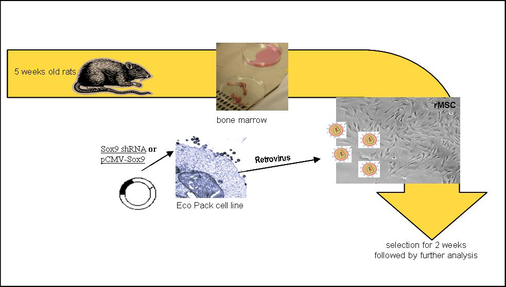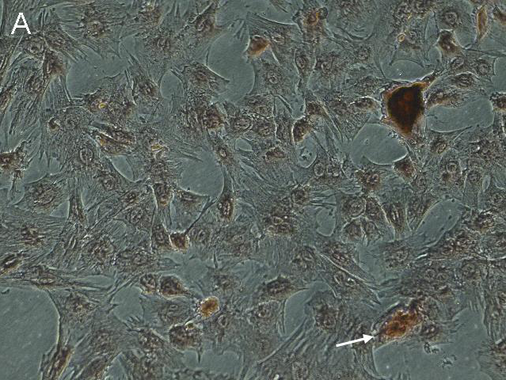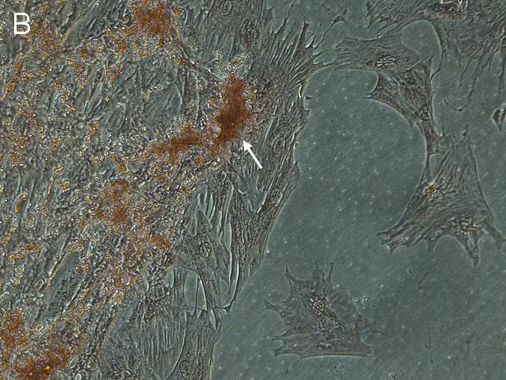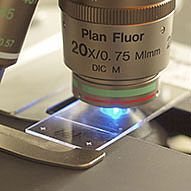
In vitro gene knock-down of Sox9 via RNA interference
The transcription factor Sox9 regulates skeletal growth and cartilage formation in mesenchymal stem cells and osteochondro-progenitor cells which can differentiate towards chondrocytes or osteoblasts. Sox9 is absent in hypertrophic chondrocytes where a misexpression in vivo causes lack of bone marrow, inhibition of cartilage resorption and failure of vascular invasion in mice [1]. Moreover, there is evidence that Sox9 is related to more biological processes than only to osteo-chondrogenesis, for example cell cycle regulation or tumourigenic development [2].
Due to post natal fatality of attemps for generation of Sox9 null homozygous transgenic mice, we have developed a method for a Sox9 knockdown by RNA interference to elucidate the role of the transcription factor. Overexpressing Sox9 is used to verify our results and unmask “false positive results” (off-target effects).
The aim of our study is to determine the role of Sox9 in undifferentiated rat mesenchymal stem cells (rMSC) in cell survival and its impact on osteogenic and chondrogenic differentiation capacity in vitro.
Our data so far demonstrate downstream effects of Sox9 silencing on the expression of Integrin alpha 11, Mmp13, Bcl-2 and Osteocalcin in undifferentiated rMSC.
Cell cycle analysis via FACS, a BrdU assay and measurement of cell doubling time displays a reduction of proliferation after Sox9 knockdown and a reduced S-phase population. Quantifying the caspase 3/7 activity suggests an increased apoptosis rate in Sox9 knockdown cells.
The protein amount of p21 and Cyclin D1, analyzed via western blotting, is clearly increased after Sox9 inhibition.
These effects are opposing after overexpressing Sox9 in undifferentiated rMSC and thus validate our inhibition data.
Furthermore, osteogenic differentiation studies demonstrate an upregulation of Runx2, Mmp13, Vegfa and Osteocalcin in Sox9 knockdown cells after 14 days of osteogenesis, whereas Msx2 and Dlx5 expression, two inhibitors of the Osteocalcin transcription, is diminished.
Moreover, we investigate in current studies:
- the impact of overexpressing Sox9 on osteogenic and chondrogenic differentiation
- the cellular localisation of p21 and Cyclin D1 in Sox9 knockdown cells
- the pathways involved in the regulation of p21 and Cyclin D1
Reference List
1.Hattori T, Muller C, Gebhard S, Bauer E, Pausch F, Schlund B, Bosl MR, Hess A, Surmann-Schmitt C, von der MH, de Crombrugghe B, von der Mark K (2010) SOX9 is a major negative regulator of cartilage vascularization, bone marrow formation and endochondral ossification. Development 137:901-911
2.Shih Sheng Jiang, Wen-Tsen Fang, Ya-Shieu Hou (2010) Upregulation of SOX9 in Lung Adenocarcinoma and Its Involvement in the Regulation of Cell Growth and Tumorigenicity. Clin Cancer Res. 16(17):4363-73
I

Figure 1:
Overview of the experimental setting for silencing or overexpressing Sox9 in rMSC.
-->

Figure 2: Osteogenic differentiation of rMSC which was verified by staining with Alicarin S Red (calcium deposition).
rMSC cultured for 7 days (A) in osteogenic differentiation medium show morphological characteristics of osteo-progenitor cells. After 14 days (B) of differentiation, the outspreading shape of osteoblasts can be monitored. Arrows indicate calcium inclusion.
-->
Grants
This work is supported by the Deutsche Forschungsgemeinschaft (grant GR 1301/7-1 and 7-2)
Investigators
Prof. Dr. Susanne Grässel, principal investigator , Sabine Stöckl, Dipl. Biol., Mandy Vogel, Technician, Claudia Göttl, Technician; Dr. Robert Springorum, Orthopedic Surgery, University Hospital of Regensburg
Collaborations
Prof. Dr. Anja Bosserhoff, Dept. of Pathology, University Hospital of Regensburg

